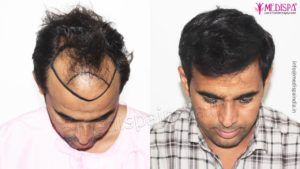
Hair transplantation is a procedure that involves extracting follicular grafts from a donor area, which can be any part of the body where hair is available, and transplanting them to the recipient site. There are two techniques commonly used for hair transplantation: FUT (Follicular Unit Transplantation or strip technique) and FUE (Follicular Unit Extraction).
In the FUT technique, a thin strip is extracted from the back and sides of the head (donor area), and the grafts are then separated under high magnification before being transplanted to the recipient site. On the other hand, the FUE technique involves individually harvesting hair follicles from the donor area using a punch tool, and then transplanting the grafts to the recipient site.
In cases where more than 4000 grafts are required, a combination technique of FUT + FUE is often employed. This technique offers additional benefits compared to using either technique alone.
Steps of hair transplant
The hair transplant procedure consists of several steps that are performed in a single session. These steps include:
- Trimming the hair in the donor area: The extent of shaving the head depends on the chosen technique. For FUT technique, complete shaving is not required, unlike FUE technique where the head is completely shaved.
- Local anesthesia in the donor area: Once the head is trimmed according to the technique, the donor area is locally anesthetized to ensure a painless procedure.
- Extraction of hair follicles: Hair follicles are carefully extracted from the donor area, taking into consideration the safe area and avoiding overharvesting. The extraction method depends on the chosen technique, whether it’s FUT, FUE, or a combination technique. These procedures are performed under high magnification.
- Graft harvesting and suturing: In the case of FUT and combination techniques, the harvested tissue is sent to technicians for graft harvesting. Afterward, the donor area is sutured using the trichophytic closure method to achieve a nearly invisible scar.
- Local anesthesia in the recipient area: The recipient area is then locally anesthetized in preparation for the implantation of hair follicles.
- Implantation of follicular grafts: The follicular grafts obtained from the donor site are carefully placed in tiny spaces created according to the natural hairline design in the recipient area.
- Placement of grafts for a natural appearance: Single grafts are placed in the front line and temporal triangles to achieve a natural appearance. Multiple and thick grafts are then placed in the rear lines to create a fuller look.
- Post-procedure care: After the procedure, tiny clots may be visible in the transplanted site. These will be washed by a professional team after 24 hours.
- Post-operative instructions: Detailed instructions will be provided for the patient to follow for approximately 15 days after the hair transplantation procedure.
DIFFERENT TYPES OF HAIR TRANSPLANT
- Scalp hair transplant: Hair transplantation on the scalp involves extracting hair grafts from the donor area, which can be the back and sides of the head or body hairs, and implanting them into the bald spots on the scalp, such as the frontal and vertex areas.
- Facial hair transplant: For facial hair transplants, hair grafts are taken from the donor area, which can be the back and sides of the head or body hairs, and then transplanted into areas like the beard, moustache, and eyebrows.
- Body hair transplant: To ensure the success of a hair transplant procedure, a sufficient number of hair follicles must be available in the donor area. While the back and sides of the head are commonly used for harvesting hair grafts, body hairs can also serve as an alternative donor site, leading to what is known as body hair transplantation.
Indians are renowned for their strong work ethic and expertise in hand sculpting. This legacy has been passed down to a select group of hair transplant surgeons in India who specialize in the art of hair transplantation. The process of hair transplantation requires immense creativity in order to sculpt the hairline at the correct angles for natural-looking results. Dr. Suneet Soni, the founder of Medispa center, is one such fortunate surgeon who possesses both exceptional surgical skills as a plastic surgeon and a true passion for artistry. With his unique artistic talent and innovative approach, Dr. Soni ensures that the hairline design is meticulously crafted to achieve natural outcomes.
Despite maintaining high standards, the hair transplant cost in India remains affordable. Delhi and Jaipur have emerged as the most sought-after and reasonably priced destinations for hair transplant procedures in India, attracting patients from both within the country and abroad. Many individuals are now choosing to undergo their hair transplants at the renowned “Medispa hair transplant centers” located in Delhi and Jaipur.
Hair transplant effectiveness
Male pattern baldness patients who opt for hair transplantation experience a range of benefits, such as:
- Enhanced appearance: In today’s society, one’s personality and appearance play a crucial role in boosting self-esteem and achieving success in various social and professional settings. Successful hair transplantation leads to a more natural look, bringing joy to those who have struggled with hair loss.
- Provides long-lasting results: Hair transplantation is the only treatment method that offers permanent results. The hair follicles in areas resistant to DHT remain unaffected by hormonal changes and remain in place permanently. The genetic characteristics of the hair are preserved within the follicle itself, allowing transplanted hairs to maintain their original features rather than adapting to scalp characteristics. Consequently, the recipient’s balding area benefits from the enduring effects of the transplanted hairs from the back and sides of the head.
- Long-term advantages: The hair transplant provides the option of multiple sessions for individuals with advanced hair loss and complete baldness. The FUT hair transplant procedure or a combination of FUT and FUE techniques enables the preservation of hair follicles for future use.
- Achieving natural results: Recent technological advancements have made it possible to achieve world-class natural outcomes. When performed by a skilled and experienced surgeon, the surgery can result in a natural-looking outcome. The key factor in achieving a natural and undetectable appearance is the design of the hairline. Careful planning of the arrangement, alignment, and angulations of the follicular transplants is essential to ensure an appealing result.





